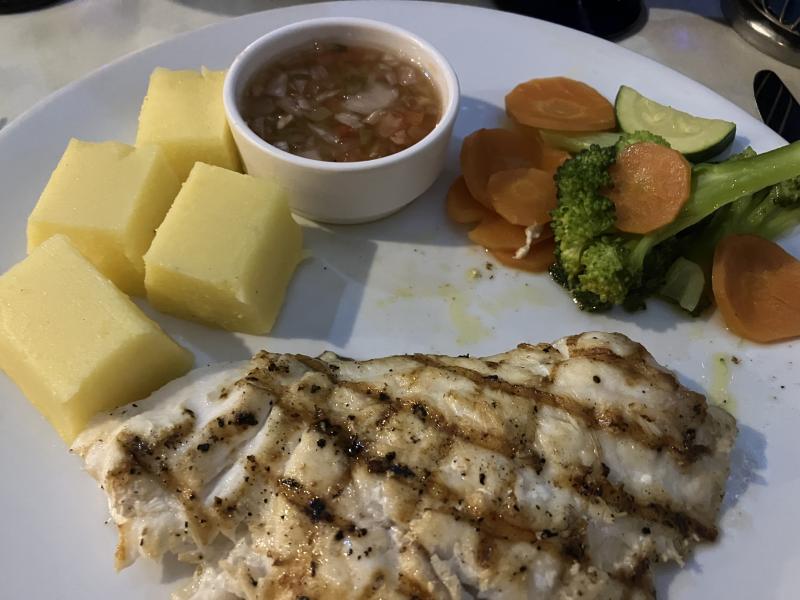Grouper: Appealing to diners, versatile for chefs
I’ve just returned from a week in Aruba, a small island in the southern Caribbean Sea, about fifteen miles north of Venezuela. The weather was ideal for a restful vacation, warm with a steady breeze and only a single day of scattered rain showers. My friend, Laurie and I spent our time relaxing at the beach or poolside, with regular excursions to coffee shops and local dining spots.
At Aruba seafood restaurants, one fish typically found on the menu is grouper, which is available all year. The flavor of the white, flaky flesh is mild and subtle, making it appealing to diners and versatile for chefs eager to apply their skills. I tried several different preparations, including the grilled filet and the almond-crusted dishes in the photos.
All groupers are members of the sea bass family, Serranidae, which is made up of more than four-hundred species. The name "grouper" comes from the Portuguese word garoupa, which is thought to have originated in a Southeast Asian name, kerapu. The dusky grouper has been popular with Mediterranean fishermen since prehistoric times; their bones have been found in human settlements dating back more than 100,000 years.
According to the journal, Antiquities, several fish species depicted in ancient mosaics were detailed enough to be recognizable as dusky groupers. However, unlike today’s animals, the ones depicted were enormous - in one case, big enough to attack and consume a fisherman whole. Even today, the large, thick, elongated body of groupers can grow to over eight feet in length and up to eight-hundred pounds.
Food historian, Alan Davidson describes some of the behaviors of solitary groupers living in coral reefs, where their mottled coloring provides perfect camouflage. They have been reported to befriend visiting divers or rush out of their hiding places to attack fishermen. One tale features an underwater photographer with a pouch full of crawfish tails who had his pockets picked by an enterprising Nassau grouper.
Most grouper are caught with the traditional hook-and-line fishing method and the highest quality are brought to market while still alive. Groupers vary in size and weight but are commonly marketed at five to twenty pounds. If you see grouper at our local fish markets, they were likely harvested in Florida, which provides eighty-five percent of the supply in the United States.
When shopping for grouper, look for firm fish without much aroma. Fresh whole fish should have a shiny surface with tightly adhering scales, gills that are deep red or pink, and a clean, shiny belly cavity with no cuts or protruding bones. Fresh steaks and fillets should be firm and translucent-looking, with no discoloration. The best way to protect yourself from substitutions is to know that grouper is a lean, firm, white-fleshed fish with a meaty texture and large flake.
Since grouper fillets are not as delicate as some other types of fish, they will stand up to grilling, frying, steaming, and baking. If it’s not grilling weather, you can also make the recipe here in a stovetop grill pan or cast iron skillet. The foil-wrapped grouper recipe can be modified to include your favorite herbs and seasonings, but this is a good place to start. As I tried to reverse-engineer the recipe for almond-crusted grouper, I realized a better solution is to plan a visit to Madame Janette in Aruba.
Grilled Grouper
vegetable oil
1 1/4 lb grouper filets
2 T butter
zest & juice of 1 lime
salt & pepper, to taste
Oil grill grate or fish basket with vegetable oil. Set grill on medium-high and preheat. Whisk together butter, lime juice, and zest in a small bowl. Use your hands or a brush to coat the mixture on both sides of the grouper filets. Place the fish directly onto oiled grate or into fish basket and onto grill. Cook, turning once until the fish is opaque and golden brown on the outside, about 4-6 minutes per side. Yield: 4 servings.
Grouper in Parchment
4 yukon gold potatoes
4 grouper filets
1/4 C olive oil
1/4 C orange juice
1/3 C chopped kalamata olives
1/3 C chopped pistachios
3 thinly sliced garlic cloves
1 T chopped parsley
salt & pepper
1 thinly sliced lemon
red pepper flakes
Preheat oven to 375F. Place potatoes in a pot with water to cover. Boil until tender, about 10 minutes. Drain and set aside to cool. Combine olive oil, orange juice, olives, pistachios, garlic, and parsley in a microwave-safe bowl. Heat for 30 seconds and stir; set aside. Pat dry grouper fillets with paper towels. Season each filet with salt and pepper; set aside. Cut potatoes into 1/4- inch thick slices; set aside. Cut four pieces of parchment paper large enough to hold the filets. Arrange potato slices down th center, overlapping slightly. Spread with 1 T of olive mixture. Place grouper filet over potatoes; spread with 1 T of olive mixture. Place lemon slices on top. Close each packet by folding and sealing the edges; place packets on a baking sheet. Bake for 18-20 minutes. Remove pan from oven and allow to cool for 5 minutes. Cut open each packet and transfer to a dinner plate; garnish with red pepper flakes. Yield: 4 servings.




















































